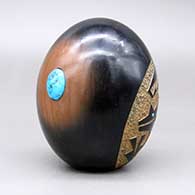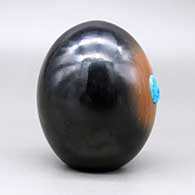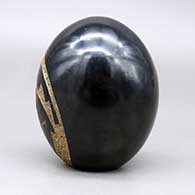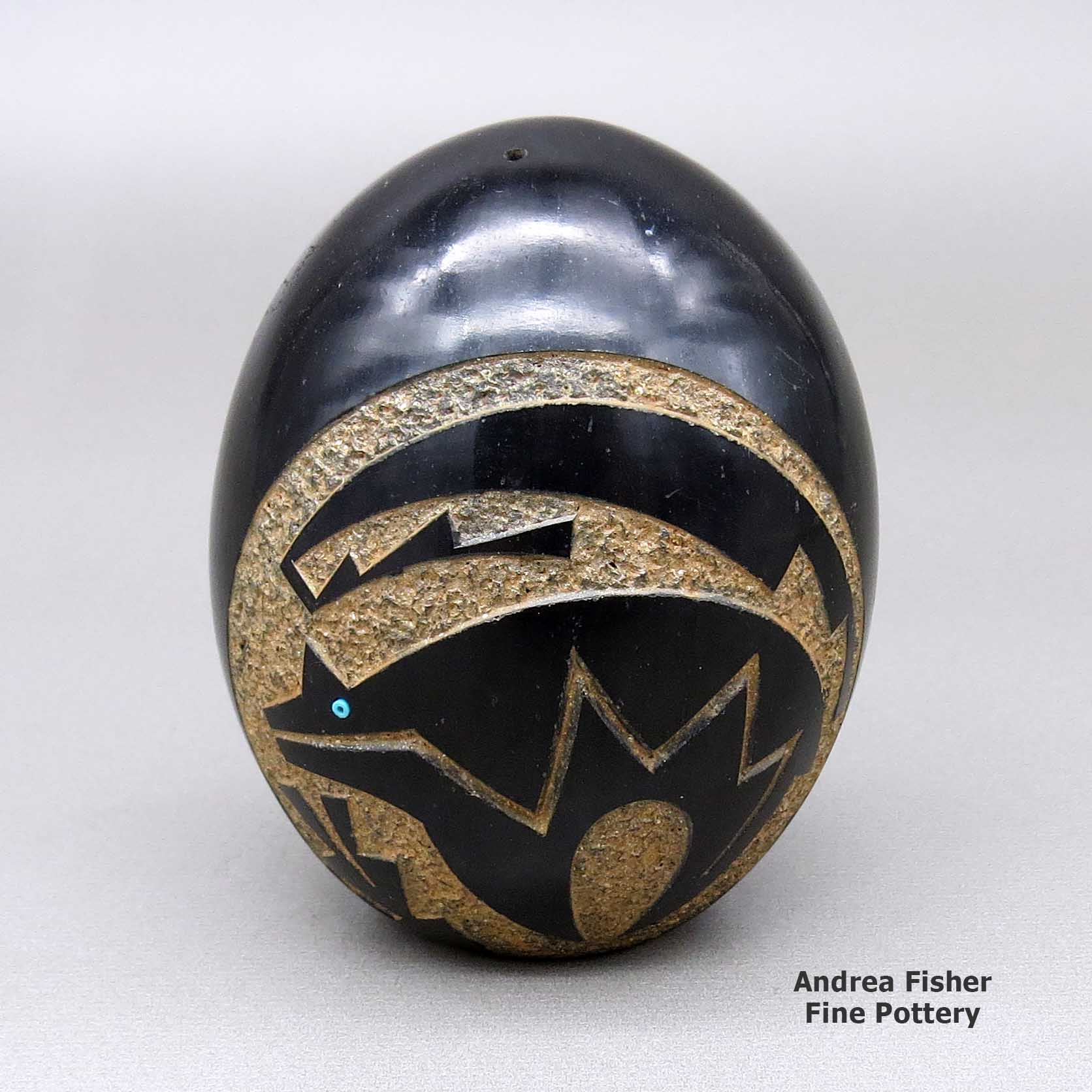
San Ildefonso
$ 350
plza4b184
Black seed pot with a sienna spot, a sgraffito bear-with-heart-line and geometric design, and inlaid turquoise stone and heishi bead details
2.75 in L by 2.75 in W by 3.5 in H
Condition: Very good, adhesive residue on bottom and wear on side
Signature: TP
Tell me more! Buy this piece!
(505) 986-1234 - www.andreafisherpottery.com - All Rights Reserved
TsePe
San Ildefonso
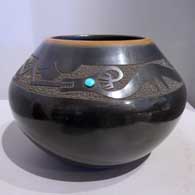
TsePe was born into San Ildefonso Pueblo in 1940. His parents, Robert and Rose Gonzales, first named him John but he changed that just after he finished high school. TsePe learned how to make pottery while watching his mother as he grew up. She was from San Juan Pueblo and deep-carved her pieces while TsePe learned to prefer sgraffito and low relief carving.
When he was 19, TsePe married Dora Gachupin of Zia Pueblo. Contrary to Pueblo tradition, she moved to his home at San Ildefonso. She had learned the Zia way of making pottery as she grew up. At San Ildefonso she learned the San Ildefonso way of making pottery from her mother-in-law. Together, TsePe and Dora were exposed to the works of Popovi and Tony Da from San Ildefonso and Joseph Lonewolf, Camilio Tafoya and Grace Medicine Flower from Santa Clara. They all worked to push the quality of sgraffito work higher and higher. TsePe also added turquoise and heishe bead inlays and micaceous and green clays to his pottery, styles adopted and developed further by Russell Sanchez.
TsePe and Dora divorced around 1979 and Dora went on to an award-winning career on her own. TsePe met and married Jennifer Sisneros of Santa Clara soon after the divorce. TsePe passed on in 2000 and Jennifer moved back to Santa Clara, reassumed her maiden name and later married Alfred Naranjo. TsePe did influence her pottery-making style in that she added green and micaceous slips to her repertoire.
TsePe always credited his mother with inspiring him to be a potter. His daughters, Andrea, Candace, Gerri, Irene and Jennifer, credit both TsePe and Dora with inspiring them.
Some Awards TsePe Won
- 1976 - Second Place ribbon with Dora, incised bowl, Santa Fe Indian Market
- 1978 - Second Place ribbon with Dora, carved black jar, Santa Fe Indian Market
- 1978 - Second Place ribbon with Dora, carved black jar with avanyu design, Santa Fe Indian Market
San Ildefonso Pueblo
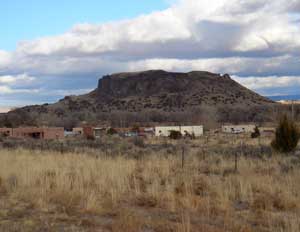
Black Mesa at San Ildefonso Pueblo
San Ildefonso Pueblo is located about twenty miles northwest of Santa Fe, New Mexico, mostly on the eastern bank of the Rio Grande. Although their ancestry has been traced to prehistoric pueblos in the Mesa Verde area, their most recent ancestral home is in the area of Bandelier National Monument, the prehistoric village of Tsankawi in particular. Tsankawi abuts the reservation on its northwest side.
A mission church was built in 1617 and named for San Ildefonso. Hence the name. Before that the village was called Powhoge, "where the water cuts through" (in Tewa). Today's pueblo was established as long ago as the 1300s. When the Spanish arrived in 1540, they estimated the village population at about 2,000.
That mission was destroyed during the Pueblo Revolt of 1680 and when Don Diego de Vargas returned to reclaim the San Ildefonso area in 1694, he found virtually all the Tewa people on top of nearby Black Mesa. After an extended siege the two sides negotiated a treaty and the people returned to their villages. However, the next 250 years were not good for them. The Spanish swine flu pandemic of 1918 reduced the pueblo's population to about 90. Their population has grown to more than 600 now but the only economic activity available on the pueblo involves creating art in one form or another. The only other work is off-pueblo. San Ildefonso's population is small compared to neighboring Santa Clara Pueblo, but the pueblo maintains its own religious traditions and ceremonial feast days.
San Ildefonso is most known for being the home of the most famous Pueblo Indian potter, Maria Martinez. Many other excellent potters from this pueblo have produced quality pottery, too, among them: Blue Corn, Tonita and Juan Roybal, Dora Tse Pe and Rose Gonzales. Of course the descendants of Maria Martinez are still important pillars of San Ildefonso's pottery tradition. Maria's influence reached far and wide, so far and wide that even Juan Quezada of the Mata Ortiz pottery renaissance in Chihuahua, Mexico, came to San Ildefonso to learn from her.
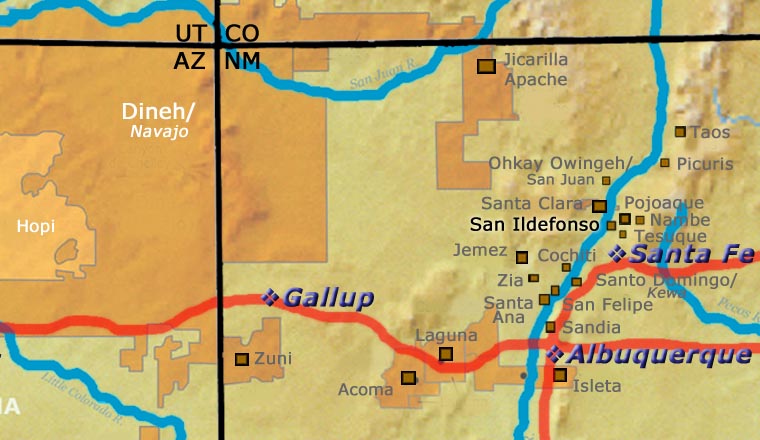
San Ildefonso Pueblo at Wikipedia
Pueblo of San Ildefonso official website
Pueblos of the Rio Grande, by Daniel Gibson
Photo is in the public domain
Seed Pots
Acoma, Hopi, Isleta, Jemez, Laguna, San Felipe, San Ildefonso, San Juan, Santa Clara
Acoma Pueblo
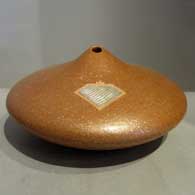
Hopi
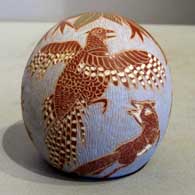
Santa Clara Pueblo
It was a matter of survival to the ancient Native American people that seeds be stored properly until the next planting season. Small, hollow pots were made to ensure that the precious seeds would be kept safe from moisture, light and rodents. After seeds were put into the pot, the small hole in the pot was plugged. The following spring the plug was removed and the seeds were shaken from the pot directly onto the planting area.
Today, seed pots are no longer necessary due to readily available seeds from commercial suppliers. However, seed pots continue to be made as beautiful, decorative works of art. The sizes and shapes of seed pots have evolved and vary greatly, depending on the vision of Clay Mother as seen through the artist. The decorations vary, too, from simple white seed pots with raised relief to multi-colored painted, raised relief and sgraffito designs, sometimes with inlaid gemstones and silver lids.
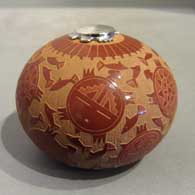
Santa Clara Pueblo
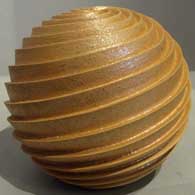
Jemez Pueblo
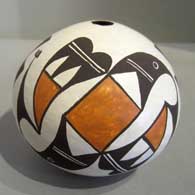
Acoma Pueblo
Gonzales Family Tree
Disclaimer: This "family tree" is a best effort on our part to determine who the potters are in this family and arrange them in a generational order. The general information available is questionable so we have tried to show each of these diagrams to living members of each family to get their input and approval, too. This diagram is subject to change should we get better info.
-
Ramona Sanchez Gonzales (1885-), second wife of Juan Gonzales (painter)
- Rose (Cata) Gonzales (daughter-in-law) (1900-1989) & Robert Gonzales (1900-1935)
- (Johnnie) Tse-Pe (Gonzales)(1940-2000) & Dora Tse-Pe (Gachupin, first wife, Zia, 1939-2022)
- Andrea Tse Pe (1975-)
- Candace Tse-Pe (1968-)
- Gerri Tse-Pe (1963-)
- Irene Tse-Pe (1961-)
- Jennifer Tse-Pe (1960-1977)
- (Johnnie) Tse-Pe (1940-2000) & Jennifer Tse Pe (Sisneros - second wife, Santa Clara)
- (Johnnie) Tse-Pe (Gonzales)(1940-2000) & Dora Tse-Pe (Gachupin, first wife, Zia, 1939-2022)
- Blue Corn (Crucita Gonzales Calabaza)(1921-1999)(step-daughter of Ramona) & Santiago Calabaza (Santo Domingo) (d. 1972)
- Joseph Calabaza (Tha Mo Thay)
- Diane Calabaza-Jenkins (Heishi Flower) (1955-)
- Elliot Calabaza
- Juanita Gonzales (1909-1988) & Louis "Wo-Peen" Gonzales (brother of Rose Gonzales husband)(1905-1992)
- Adelphia Martinez (1935-2022)
- Lorenzo Gonzales (1922-1995)(adopted by Louis & Juanita Gonzales) & Delores Naquayoma (Hopi/Winnebago)
- Jeanne M. Gonzales (1959-)
- John Gonzales (1955-)
- Laurencita Gonzales
- Linda Gonzales
- Marie Ann Gonzales
- Raymond Gonzales
- Robert Gonzales
- Oqwa Pi (Abel Sanchez)(1899-1971) & Tomasena Cata Sanchez (1903-1985)
- Skipped generation
- Russell Sanchez (1966-)
- Skipped generation
Rose' students:
Some of the above info is drawn from Pueblo Indian Pottery, 750 Artist Biographies, by Gregory Schaaf, © 2000, Center for Indigenous Arts & Studies
Other info is derived from personal contacts with family members and through interminable searches of the Internet.
Copyright © 1998-2024 by


